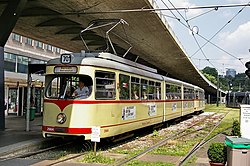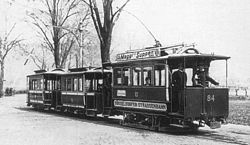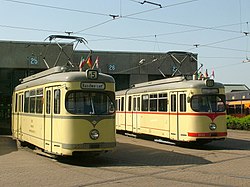The Street railway journal (1899) (14572730697)
Identifier: streetrailwayjo151899newy (find matches)
Title: The Street railway journal
Year: 1884 (1880s)
Authors:
Subjects: Street-railroads Electric railroads Transportation
Publisher: New York : McGraw Pub. Co.
Contributing Library: Smithsonian Libraries
Digitizing Sponsor: Smithsonian Libraries
View Book Page: Book Viewer
About This Book: Catalog Entry
View All Images: All Images From Book
Click here to view book online to see this illustration in context in a browseable online version of this book.
Text Appearing Before Image:
us- portion consists of two large spans of 183 meters (600 ft.)each, framed by immense sandstone portals. At eitherside are a number of smaller spans. For the railroad twotracks have been laid, and two vehicles can pass outsideof them at one time with ease. At each side of this road-way are two conveniently wide passenger walks. As the electric road parallels a steam railway for thegreater part of its length it was necessary to adopt a speedof 40 km. (25 miles) per hour on open stretches, and herethe highway was avoided as much as possible. For thisreason also the road does not pass through the interveningtowns, but only touches them on the outskirts. The route is shown in the map on page 527. The totallength of the road from the Haroldstrasse in Dusseldorfto the Rheinstrasse in Krefeld, is 22 km. (13.6 miles). Thelength of the open stretch between the stopping places,Oberkassel and the Krefeld depot, is 16.7 km. (10.4 miles).The steepest grade is that of the bridge approaches, and is
Text Appearing After Image:
MOTOR CAR AND TWO TRAIL CARS ON S CURVE IN KREFELD tries and as an important railway center and river harbor,has long felt the lack of opportunity to extend more thanin one direction on account of the broad river; whileKrefeld, situated 6 km. to the left of the Rhine, and thecenter of the German silk and velvet industry, has felt thenecessity of being connected with the neighboring city onaccount of railroad facilities. In 1891 the State Minister of Railroads announced thatthe Government was not willing to grant the subsidy neces-sary for the building of the bridge across the Rhine requiredfor the projected line, but if the city of Dusseldorf, or a stockcompany, would build the bridge at its own expense, itcould obtain permission for the collection of a reasonablebridge toll. Finally all difficulties were overcome, andthe Rheinische Bahngesellchaft was formed in March,1896, for the purpose of constructing the required bridgeat Dusseldorf and an electric railroad from that city toKrefe
Note About Images
Relevantní obrázky
Relevantní články
Tramvajová doprava v DüsseldorfuTramvajová doprava tvoří v Düsseldorfu, hlavním městě německé spolkové země Severní Porýní-Vestfálsko, společně s vlaky S-Bahn, městskou dráhou a autobusy páteř městské hromadné dopravy. První tramvaje vyjely do ulic Düsseldorfu 6. února 1876. Celkem je v provozu 7 linek, z nichž jedna zajíždí i do sousedního města Neuss. Provozovatelem systému je městský dopravní podnik Rheinbahn. Celá síť je integrována do tarifu místního dopravního systému Verkehrsverbund Rhein-Ruhr (VRR). .. pokračovat ve čtení











